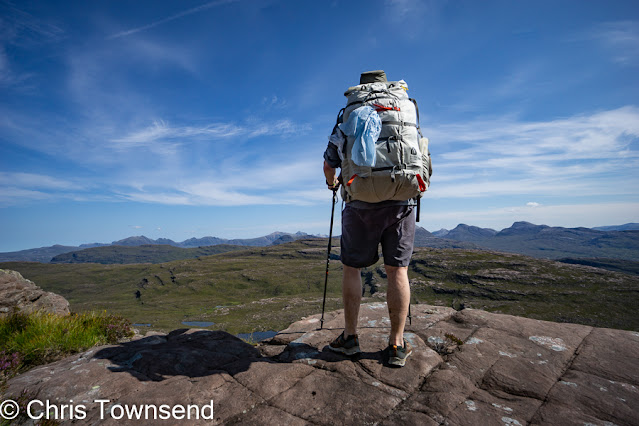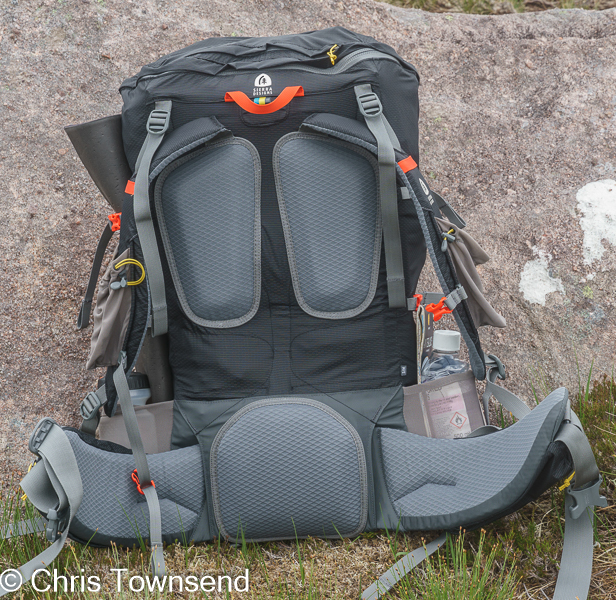Following my January 18 post on packs I’ve used on long walks over the years here are some more thoughts. This is adapted from an introduction to a review of big packs for The Great Outdoors a few years ago. I’ve expanded it and added my preferences.
Along with footwear your pack is a key to enjoying a long walk. A pack that hurts or is irritatingly uncomfortable can ruin a walk very quickly.
A 50-60 litre pack is ideal for most backpacking with room for all your gear plus a few days’ supplies. The number of litres should only be taken as a guide though – some companies litres are bigger than others! Also, some companies include pocket capacity, others just the main body of the pack. When choosing a pack think about how your gear will fit inside. If you’ll be going out with bulkier winter gear or many days’ food a pack around 60 litres or even more might be needed. Because I like being able to pack quickly without having to be precise about where everything goes (I’m not that neat at packing) I like a 60 litre pack for any walk where I’ll be carrying more than two or three days supplies.
Weight
A rough rule of thumb I used for years is that the empty pack shouldn’t weigh much more than 10% of the total weight you’ll be carrying. This includes food and water, not just gear. These days many packs come in at under 10% of the maximum weight they’ll handle due to lighter materials that are just as strong as the older heavier ones. This is progress!
How much weight a pack can handle comfortably depends on the back system, regardless of volume or the weight of the pack itself. I think a 50-60 litre pack should be fine with at least 15kg. Some companies give a suggested maximum load, but many don’t.
Back System
For heavier loads, certainly those above 10kg, I always look for a back system with a frame to give stiffness and help transmit the load to the hipbelt. Frameless packs can handle heavy loads if well-designed and carefully packed but, frankly, after using them for a few years I decided getting them comfortable was too much hassle and I’d rather carry the extra weight of a frame.
A frame needs to be the right length for your back and some packs come in several lengths for this. Adjustable backs with shoulder straps that slide up and down are good for fine tuning the fit, but the frame still needs to be roughly the right length. It’s always best to try on loaded packs to check the fit. The frame shouldn’t come very far above the top of the shoulders when the hipbelt is tightened round the hips. Too long a frame and the pack is likely to feel unstable, too short and the hipbelt is likely to be too high up and won’t bear the weight. The last is important as the hipbelt is key to comfort and should be thick enough, stiff enough and wide enough to support most of the load.
Lids/Closure
A lid should fit closely over the biggest load. Some can be extended to do this, some just stretch, which can have limits. Detachable lids can cover items such as foam pads carried above the main pack body. Roll top closures can be used for this too and are easy and quick to use. Zip round closures are also easy to use but the pack can’t be extended for oversize loads. I don’t have a preference other than that the top should be easy and quick to open with cold or gloved hands.
Pockets/Compartments
Pockets are useful for organising gear, especially small items that might be needed during the day. Lower compartments can be useful for sleeping bags and for clothing that might be needed during the day – I don’t regard them as essential though. Mesh pockets are useful for wet items, allowing them to drain and dry out. Large ones can even be used for tents. I like big mesh front pockets – though one of my current favourite packs doesn’t have them due to its strap arrangement, which I also like.
External straps can be used for attaching items such as foam pads or trekking poles or a wet tent, as in the picture below. They're also useful for compressing the size of the pack when a small load is carried. Straps should be easy to adjust and shouldn’t interfere with access to pockets.
Rain cover?
Packs are usually made of waterproof materials, but the seams aren’t sealed and can leak so sensitive gear needs protecting from rain. Many packs come with waterproof covers. I prefer to use pack liners and dry bags as covers can blow off or tear and can be awkward to use if you have anything strapped on the outside of the pack. They also have to be removed to access the contents. I now use several drybags in different sizes.







No comments:
Post a Comment